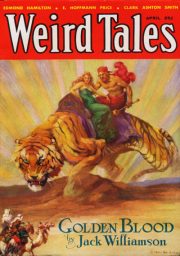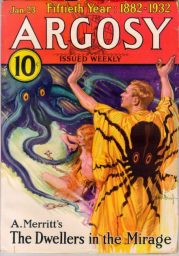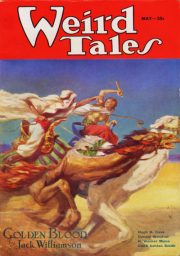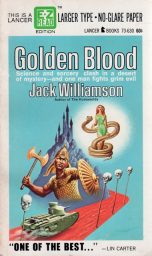 Robert E. Howard’s The Hour of the Dragon was the greatest novel to appear in Weird Tales. Jack Williamson’s Golden Blood was the second greatest novel to appear in Weird Tales.
Robert E. Howard’s The Hour of the Dragon was the greatest novel to appear in Weird Tales. Jack Williamson’s Golden Blood was the second greatest novel to appear in Weird Tales.
Jack William had a total of six stories and two serials in Weird Tales from 1932 through 1938. He also had almost as many rejections from the magazine.
Golden Blood is one of my favorite lost race novels. That is a story type almost forgotten today. An exotic unknown civilization or remnant of a past civilization is found in some uncharted portion of the globe. By the time of this novel, the story form was past its glory days going back to H. Rider Haggard’s She and Allan Quatermain in the 1880s.
Edgar Rice Burroughs got a lot of mileage out of the lost race story. The other writer who wrote very fantastic lost race novels was A. Merritt. The Moon Pool, The Metal Monster, The Face in the Abyss, and The Dwellers in the Mirage were hugely popular. Those books had multiple printings right up to the end of the 1970s.
Merritt was influential on some of the up and coming science fiction writers that would take part in the “Golden Age.” P. Schuyler Miller, Edmond Hamilton, C. L. Moore, and  Hannes Bok. Early Jack Williamson is full of Merritt influence. You see it with his first story (“The Metal Man,” Amazing Stories December 1928) through the three part serial “Xandulu” (Wonder Stories, March-May 1934).
Hannes Bok. Early Jack Williamson is full of Merritt influence. You see it with his first story (“The Metal Man,” Amazing Stories December 1928) through the three part serial “Xandulu” (Wonder Stories, March-May 1934).
Williamson wrote “Golden Blood” in the fall of 1932. He wrote it so it could be broken up into six installments of 10,000 words for Argosy. The editor at Argosy rejected “Golden Blood” but Williamson was able to sell it to Weird Tales. It was his second sale to Weird Tales.
The novel ran as a six part serial in Weird Tales from April to September 1933. The April issue included fiction by E. Hoffmann Price, Carl Jacobi, and Clark Ashton Smith who was popular in the magazine. The serial overlapped with Otis Adelbert Kine’s “Buccaneers of Venus,” a Burroughsian sword and planet pastiche. The June 1933 issue shared Robert E. Howard’s “Black Colossus.” The July issue had H. P. Lovecraft’s “Dreams in the Witch House.”
“Golden Blood” also started in Weird Tales at the same time King Kong started in the theaters. Williamson was fortunate in taking two covers for his novel, both painted J. Allan St. John, famous for illustrating Edgar Rice Burroughs.
Merritt’s The Metal Monster and Dwellers in the Mirage appear to be at the forefront of influences as both are lost race novels. Dwellers had just run in Argosy in January and February 1932. That was a lost race in the depths of Asia with an American as an avatar of a reincarnated hero.
“Golden Blood” is set in the Empty Quarter of Arabia with a band of mercenaries called “The Secret Legion” off to plunder a lost city of legend rumored to be full of gold. Price Durand, soldier of fortune, commands the Secret Legion under Jacob Garth. Williamson based Durand on writer E. Hoffmann Price. Well armed with Lebel rifles, Hotchkiss machineguns, two mountain guns, and a small tank, the Secret Legion is reinforced by 50 Arab Bedouins.

There is a brief battle with guardians of a pass using a super scientific cold ray. A gigantic mirage of two golden people riding a very big tiger is also seen.
They capture an Arab girl, Aysa, who is given to a villainous Portuguese Eurasian. Durand rescues the girl from a fate worse than death where they travel to the abandoned city of Anz. It turns out Aysa was to be given to the golden folk as tribute. They find the city of Anz where Price is viewed as the prophecy of the return of King Iru. The prophecy is he will return to overthrow the tyranny of the golden people.
Durand has his first run in with Malikar of the golden people. He abducts Aysa in short order. Durand finds the Secret Legion and takes part in a failed assault on the golden people’s stronghold. Using a captured henchman of the golden people, he makes his way into their citadel. He is captured in a second show down with Malikar. There is some background info about a gold vapor from an abyss that gives immortality to those who sleep in it. Malikar has plans to turn Aysa into a golden-part metal priest of the snake.
The worship of a very big golden snake and tension present between Malikar and Vekyra who does not like it that Aysa is going to replace her adds to the drama. Vekyra also has the hots for Price Durand.
Price Duran escapes, returns once again to the Secret Legion, and is expelled when Jacob Garth makes a deal with Vekyra. Heall hath no fury like a woman scorned.
The Secret Legion assaults Malikar’s stronghold while Duran sneaks in through a back way. There is a show down with Vekyra who intends on murdering the sleeping Aysa. The Secret Legion penetrates the stronghold but is overcome by the golden vapor putting them into a sleep where a skulking Malikar disposes of them. Price Duran has a third and ultimately successful confrontation with Malikar wearing the gold mail and using the golden axe of Iru.
So, Williamson created a novel that seemed to be an homage to Dwellers in the Mirage. It is a novel that you can knock off in one day. I think it compares favorably to A. Merritt’s lost race novels.
Reader reaction to “Golden Blood” was positive. The June issue of Weird Tales contained this comment in “The Eyrie:” “I especially congratulate you on Golden Blood by Jack Williamson. This start out as the finest serial you have ever published. I have always considered A. Merritt the greatest creator of fantastic stories, but if the remainder of Golden Blood is on a par with the first part, I shall have to admit that Williamson is a close second to Merritt.”
Carl Jacobi’s classic vampire tale, “Revelations in Black” was the most popular story in the April 1932 issue with “Golden Blood” taking a close second place.
There was a big debate raging in “The Eyrie” at this time regarding the inclusion of science fiction in Weird Tales. This was part of a bigger war between science fiction purists who wanted no weird or horror tinged stories in the science fiction magazines. There was a small but vocal few who wanted no “weird-scientific” in Weird Tales. The impression given is most readers wanted variety.
“Golden Blood” did take first place in the May 1932 issue. Conan the Cimmerian in “Black Colossus” took first place in the June 1932 issue.
The October, 1932 issue had this from Jack Darrow in “The Eyrie:” “I found the August issue of WEIRD TALES a might good one. Golden Blood can not be given too much praise. Page after absorbing page the reader is carried through what is Jack Williamson’s greatest piece of work.”
Golden Blood would not be reprinted in book form until 1964 by Lancer Books. Tim Underwood and Bill Ross’ Tamerlane Press produced a hardback in 1978, limited to 1500 copies. Jack Williamson did some revision to the text. That was probably for copyright reasons. Weird Tales had a habit of not copyrighting its issues for most of the 1930s. Williamson probably found the original copyright did not exist so he created a variant text that could be copyrighted.

Second paperback edition, 1967.
The Tamerlane Press hardback was the last book publication of the novel. Gateway/Orion did produce an e-book in 2013.
So, if you are in the mood for a fun lost race novel, check out Golden Blood. The two Lancer paperback editions are often found in used bookstores in the science fiction/fantasy section.
HOUR OF THE DRAGON is indeed the greatest WT novel. But number two is Thomas P. Kelley’s loopy masterpiece I FOUND CLEOPATRA. It’s everything you could want in a 30’s pulp novel.
Has anyone compared the revised text in the Tamerlane hardcover with the original to see what changes were made by Williamson?